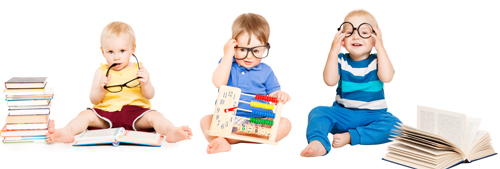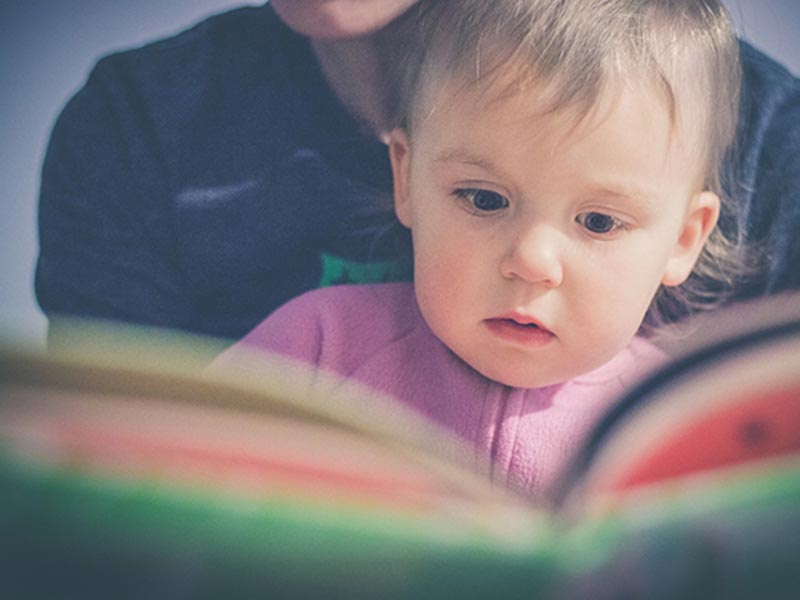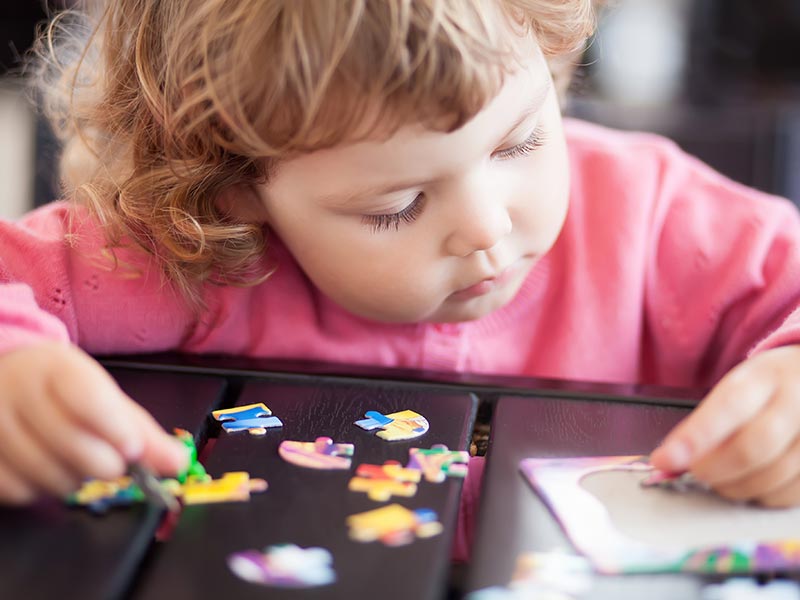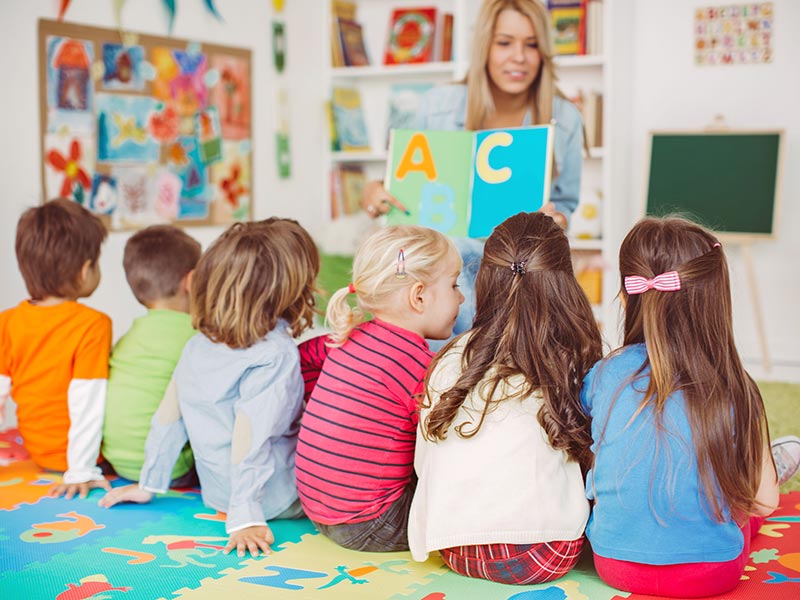




Intellectual development includes:
Mae datblygiad deallusol yn cynnwys:
Click on the answer you think is correct.
Cliciwch ar yr ateb cywir yn eich barn chi.
Drag the intellectual development to the correct age.
Llusgwch y datblygiad deallusol i'r oedran cywir.
Warning! This resource is not optimised for use on mobile devices.
Rhybudd! Ni ellir defnyddio’r adnodd yma ar ffonau symudol neu dabled.
Well done. You have matched them all correctly.
Da iawn. Rydych wedi paru pob un yn gywir.
|
Age
Oed
|
Development
Datblygiad
|
Correct answers
Atebion cywir
|
|---|

Children develop language skills at a very rapid rate between the ages of 0 – 5 years.
Language can be split into two sections - non-verbal and verbal communication. When a child is born it can communicate its needs through crying and facial expressions. This usually applies to the first 12 months of life.
The ability to understand language usually happens before the ability to communicate. Children start to communicate verbally through babbling and then through using 1 or 2 words. This then turns into stringing 2 words together, and then 3, and then whole sentences.
Adults help babies and children develop language by talking to them in a particular way and by repeating the same words and phrases. Once a child is 2 years old, they have a vocabulary of a few hundred words, this will increase rapidly. The rate of vocabulary development is influenced by how much speech they are exposed to. The more an adult talks to a child, the faster their vocabulary will develop.
By 6, a child has a vocabulary of over 10,000 words. By 8, a child will be able to hold adult-like conversations.
Once the basics have been learned, language and vocabulary continue to develop through the life stages.
At the same time as children are gaining language skills, young children are learning about reading and writing.
Many play experiences support children's emerging literacy skills. Sorting, matching, classifying and sequencing materials, such as beads or a set of coloured cubes, contribute to children's emerging literacy skills, as does using role-play to recount favourite stories.
As language skills grow, young children tell stories, identify printed words, such as their names, and incorporate writing in their make-believe play.
After listening to a story, they can talk about the people, feelings, places, things and events in the book and compare them to their own experiences.
Reading and writing skills develop together. Children learn about reading and writing by seeing how the print in their homes, classrooms, and communities provides information.
Mae plant yn meithrin sgiliau iaith yn gyflym iawn rhwng 0 a 5 oed.
Gellir rhannu iaith yn ddwy adran - cyfathrebu di-eiriau a chyfathrebu geiriol. Pan gaiff plentyn ei eni, gall gyfleu ei anghenion drwy grïo a mynegiadau wyneb. Mae hyn fel arfer yn berthnasol yn ystod 12 mis cyntaf ei fywyd.
Mae'r gallu i ddeall iaith fel arfer yn digwydd cyn y gallu i gyfathrebu. Mae plant yn dechrau cyfathrebu ar lafar trwy barablu ac yna drwy ddefnyddio un neu ddau o eiriau. Mae hyn wedyn yn arwain at roi 2 air gyda'i gilydd, ac yna 3, ac yna frawddegau cyfan.
Bydd oedolion yn helpu babanod a phlant i feithrin iaith drwy siarad â nhw mewn ffordd benodol a thrwy ailadrodd yr un geiriau neu ymadroddion. Pan fydd plentyn yn cyrraedd 2 oed, bydd ganddo ychydig gannoedd o eiriau, a bydd y nifer hon yn cynyddu'n gyflym. Mae faint o siarad y bydd plentyn yn ei glywed yn dylanwadu ar gyfradd datblygu'r eirfa. Po fwyaf y bydd oedolyn yn siarad â phlentyn, y cyflymaf y bydd ei eirfa'n datblygu.
Erbyn 6 oed, bydd gan blentyn dros 10,000 o eiriau. Erbyn 8 oed, bydd plentyn yn gallu cynnal sgwrs fel oedolyn.
Unwaith y bydd wedi dysgu’r hanfodion, bydd iaith a geirfa yn parhau i ddatblygu drwy'r camau bywyd.
Ar yr un pryd ag y mae plant yn meithrin sgiliau iaith, mae plant ifanc yn dysgu darllen ac ysgrifennu.
Mae llawer o brofiadau chwarae yn cefnogi sgiliau llythrennedd datblygol plant. Mae trefnu, paru, dosbarthu a dilyniannu deunyddiau, fel gleiniau neu set o giwbiau lliw, yn cyfrannu at sgiliau llythrennedd datblygol plant. Mae defnyddio ymarferion chwarae rôl i adrodd hoff straeon hefyd yn cyfrannu at hyn.
Wrth i sgiliau iaith wella, mae plant ifanc yn adrodd straeon, yn adnabod geiriau wedi'u hargraffu, fel eu henwau, ac yn cynnwys ysgrifennu yn eu chwarae dychmygus.
Ar ôl gwrando ar stori, gallan nhw sôn am y bobl, y teimladau, y mannau, y pethau a'r digwyddiadau yn y llyfr a'u cymharu â'u profiadau eu hunain.
Mae sgiliau darllen ac ysgrifennu yn datblygu gyda'i gilydd. Mae plant yn dysgu am ddarllen ac ysgrifennu drwy weld sut mae'r deunydd print yn eu cartrefi, eu hystafelloedd dosbarth a'u cymunedau yn darparu gwybodaeth.
https://www.booktrust.org.uk/what-we-do/booktrust-cymru/
Using the link above and your wider knowledge, state ways in which learning to read contributes to infants/children’s growth and development.
https://www.booktrust.org.uk/cy-gb/what-we-do/booktrust-cymru/
Gan ddefnyddio'r linc uchod a'ch gwybodaeth ehangach, nodwch sut mae dysgu darllen yn cyfrannu at dwf a datblygiad babanod/plant.

Mental capacity is about how we use our minds and organise thinking to understand the world around us.
This is also called cognitive development and depends upon the child’s own pattern of development, the opportunity for playing with toys and games, and experiences of activities and events.
Cognitive development includes:
These skills are usually gained during childhood and develop through the life stages through education, work and life experiences.
Mae galluedd meddyliol yn ymwneud â’r ffordd rydyn ni’n defnyddio’r meddwl ac yn rhoi trefn ar ein meddyliau er mwyn deall y byd o’n cwmpas.
Mae hyn yn cael ei alw’n ddatblygiad gwybyddol hefyd ac mae’n dibynnu ar batrwm datblygu’r plentyn ei hun, y cyfle i chwarae gyda theganau a gemau a phrofi gweithgareddau a digwyddiadau.
Mae datblygiad gwybyddol yn cynnwys:
Fel rheol, bydd y sgiliau hyn yn cael eu meithrin yn ystod plentyndod a byddan nhw’n datblygu drwy gamau bywyd drwy addysg, gwaith a phrofiadau bywyd.
Bethan is 4 years old. She is an only child and her parents are concerned that her cognitive development might be slightly behind for her age.
What could her parents do to help improve this?
Mae Bethan yn 4 oed. Mae hi'n unig blentyn ac mae ei rhieni yn poeni y gallai ei datblygiad gwybyddol fod ychydig yn araf am ei hoedran.
Beth y gallai ei rhieni ei wneud i wella hyn?

Children learn in many different ways, but primarily, they learn through:
They learn more quickly if they are in a safe and nurturing environment.
Play is one of the main ways in which children learn. Children often become very absorbed in what they are doing, and this helps them develop the ability to concentrate.
There are a number of play activities that children can be introduced to which will help them learn different skills. These can include:
Problem solving skills can be developed by allowing children to try to work things out for themselves and through encouraging creative play. Children should be allowed to experience failure and also see that adults sometimes need help to solve a problem.
Children need to learn how to distinguish between right and wrong and how to make good choices. In order for this to happen they need to be surrounded by good role models.
Babies cannot understand the difference between right and wrong, they are governed by their feelings and needs.
Toddlers will follow the rules to avoid punishment, but they don’t yet understand right and wrong. They don’t understand why biting is wrong, but they know that they will be punished for doing it.
By the age of 5, a child will understand that actions have consequences, and they are aware of the rules of the family. It is during this stage of a child’s development that discipline needs to be consistent and children understand why they are being punished. It is also important that good role models surround the child.
Primary school children will now have a strong sense of right and wrong, but they will still break the rules from time to time. It is important that they feel that they are being treated fairly.
Mae plant yn dysgu mewn sawl ffordd wahanol, ond yn bennaf, maen nhw'n dysgu drwy wneud y canlynol:
Maen nhw'n dysgu'n gyflymach os ydyn nhw mewn amgylchedd diogel a meithringar.
Chwarae yw un o’r prif ffyrdd mae plant yn dysgu. Bydd plant yn aml yn ymgolli’n llwyr yn yr hyn maen nhw’n ei wneud sy’n eu helpu i ddatblygu’r gallu i ganolbwyntio.
Mae nifer o weithgareddau chwarae y gall plant gael eu cyflwyno iddyn nhw a fydd yn eu helpu i ddysgu sgiliau gwahanol. Gall y rhain gynnwys y canlynol:
Gall sgiliau datrys problemau gael eu meithrin drwy adael i’r plant roi cynnig ar weithio pethau allan drostyn nhw eu hunain a thrwy annog chwarae creadigol. Dylai plant gael cyfle i brofi sut beth yw methu a hefyd i weld bod angen i oedolion gael help i ddatrys problem weithiau.
Mae angen i blant ddysgu sut i wahaniaethu rhwng da a drwg a sut i wneud dewisiadau da. Er mwyn i hyn ddigwydd, mae angen iddyn nhw weld esiampl dda yn cael ei gosod o’u cwmpas.
Nid yw babanod yn gallu deall y gwahaniaeth rhwng da a drwg, cânt eu rheoli gan eu teimladau a'u hanghenion.
Bydd plant bach yn dilyn y rheolau er mwyn osgoi cael eu cosbi, ond dydyn nhw ddim yn deall da a drwg eto. Dydyn nhw ddim yn deall pam mae cnoi yn anghywir, ond maen nhw’n gwybod y byddan nhw’n cael eu cosbi am wneud hynny.
Erbyn bod plentyn yn 5 oed, bydd yn deall bod gan weithredoedd ganlyniadau, a bydd yn ymwybodol o reolau’r teulu. Ar y cam hwn yn natblygiad plentyn, mae angen i ddisgyblaeth fod yn gyson ac mae plant yn deall pam maen nhw’n cael eu cosbi. Mae hefyd yn bwysig bod plant yn gweld esiampl dda yn cael ei gosod o’u cwmpas.
Erbyn hyn, bydd gan blant cynradd ymdeimlad cryf o’r hyn sy’n dda ac yn ddrwg, ond byddan nhw’n dal i dorri’r rheolau o bryd i’w gilydd. Mae’n bwysig eu bod yn teimlo eu bod yn cael eu trin yn deg.